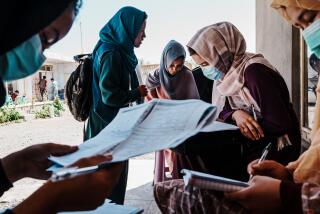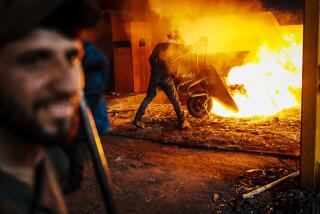U.S. Ground Forces Needed to Ensure Afghanistan Can’t Harbor Bin Laden
- Share via
Even as the rebel Northern Alliance celebrates its first significant victory in Mazar-i-Sharif, it’s important not to lose sight of the real goal for the military campaign in Afghanistan.
The task for the American forces--fighting primarily from the hair--and the rebels operating on the ground isn’t just to drive the Taliban from Afghanistan’s major cities and establish a new government--difficult as that alone might be. Top U.S. officials acknowledge that the war won’t be successful unless it also prevents the Taliban from holding enough territory in the vast countryside to shelter Osama bin Laden and his terrorist network. And that could prove a much more daunting assignment for the Northern Alliance without greater American help on the ground.
“Remember, the goal of this mission is to make it impossible to use Afghanistan as a terrorist base for Al Qaeda,” says a senior U.S. official. “So a circumstance in which he can use part of the country is not acceptable.”
That’s a real danger, though. Afghanistan has suffered through virtually uninterrupted civil war since the Soviet Union withdrew its forces in 1989--after itself failing to subjugate the countryside. The conflict has been perpetuated primarily because none of the interests involved has been strong enough to completely subdue the others.
When the forces that now constitute the Northern Alliance ruled the country in the early 1990s, “Afghanistan was in a state of virtual disintegration,” writes Pakistani journalist Ahmed Rashid in his compelling book “Taliban.” “The country was divided into warlord fiefdoms and all the warlords had fought, switched sides and fought again in a bewildering array of alliances, betrayals and bloodshed.”
The Taliban exerted more effective control after they swept into power in 1996. But even they were never able to dislodge the Northern Alliance--the remnants of the old government--from the northern strongholds where they controlled from 10% to 15% of the country (more by their estimation). When the U.S. intervened last month, the two sides had been stalemated for years, neither able to roll back the other.
Even if the Northern Alliance, with American help, ultimately drives the Taliban from power, the risk is that the two sides will simply trade places. The Northern Alliance, operating with the broader political coalition that the U.N. is now working to assemble, could move into Kabul and control much of the country. But the Taliban, reversing the Northern Alliance’s own exodus, could take to the hills, probably around Kandahar, the movement’s spiritual home in the southeastern corner of the country.
Unless the Northern Alliance could hunt down the Taliban remnant more effectively than the Taliban pursued the Northern Alliance when the roles were reversed, that could leave the radical Islamic movement with control of enough territory to both threaten the new government with guerrilla attacks--and continue sheltering Bin Laden.
Ivo Daalder, a national security aide under President Clinton, says that prospect is “one of our true nightmare scenarios” in Afghanistan. “Maybe there is a post-Taliban Afghanistan,” he says. “But there is a possibility you will have a large Taliban-like guerrilla capability present inside of Afghanistan that you will have to deal with. Is it any wonder why the United Nations says they are not going to put peacekeepers in that kind of situation?”
Haron Amin, the Northern Alliance’s representative in Washington, is more optimistic that the Taliban can be eradicated as an effective force. During its years in exile, the Northern Alliance was sustained--at least at subsistence levels--by aid from countries such as Iran and Russia that opposed the Taliban.
With the Taliban now so isolated, it would be unlikely to receive support from any government, he predicts. And, he argues, the Taliban’s rule has so alienated the country that a guerrilla Taliban force would be unable to count on much support from the general population. “For them to be able to sustain themselves without outside support--they couldn’t do it,” he says.
But that may be overly optimistic. Even if denied sponsorship from another government, a Taliban remnant could receive aid from radical Islamic networks and reinforcement from sympathizers in the thousands of religious schools across the border in Pakistan. If Bin Laden remains allied with them, he would undoubtedly generate resources and recruits as well.
These are some of the reasons that a senior U.S. intelligence official, briefing reporters earlier in the war, warned that it will be much more difficult to eliminate the Taliban as an effective force than it will be to drive them from unified control of the country. “The Taliban is unlike anything we’ve ever seen before,” the official said. “You can find vulnerabilities that are strategic and operational . . . but if you try to completely destroy them, that’s a lot more difficult, particularly when they believe themselves to be based on an idea.”
The good news is that American officials recognize the danger--and flatly insist that an informal partition of Afghanistan is unacceptable. “Of course everybody understands that’s a possibility,” says the senior policymaker. “But it is unacceptable for territory to be used [by Bin Laden] and we will do whatever we have to do to meet that condition.”
That could be quite a bit more than the U.S. has been willing to do so far. American officials acknowledge they have made little progress in encouraging an indigenous opposition in southern Afghanistan, where the Taliban is strongest. And the Northern Alliance, which has little representation from the Pushtun tribes that dominate the south, is unlikely to launch a full-scale southern invasion on its own. Indeed, as Olivier Roy, a leading French expert on Afghanistan, told The Times’ Robin Wright last week, such an attack could prove counterproductive by encouraging Pushtun nationalists to rally around the Taliban.
If all goes well in the coming months, the Northern Alliance may broaden its control over the northern half of the country and force the Taliban from Kabul. But it’s difficult to imagine the rebels completely subduing the Taliban--first in Kandahar and then as a guerrilla force in the hills--on their own. It may take American boots, in the snow and the dust, to truly stamp out this threat.
*
Ronald Brownstein’s column appears every Monday. See current and past Brownstein columns on The Times’ Web site at: https://www.latimes.com/brownstein.
More to Read
Sign up for Essential California
The most important California stories and recommendations in your inbox every morning.
You may occasionally receive promotional content from the Los Angeles Times.













